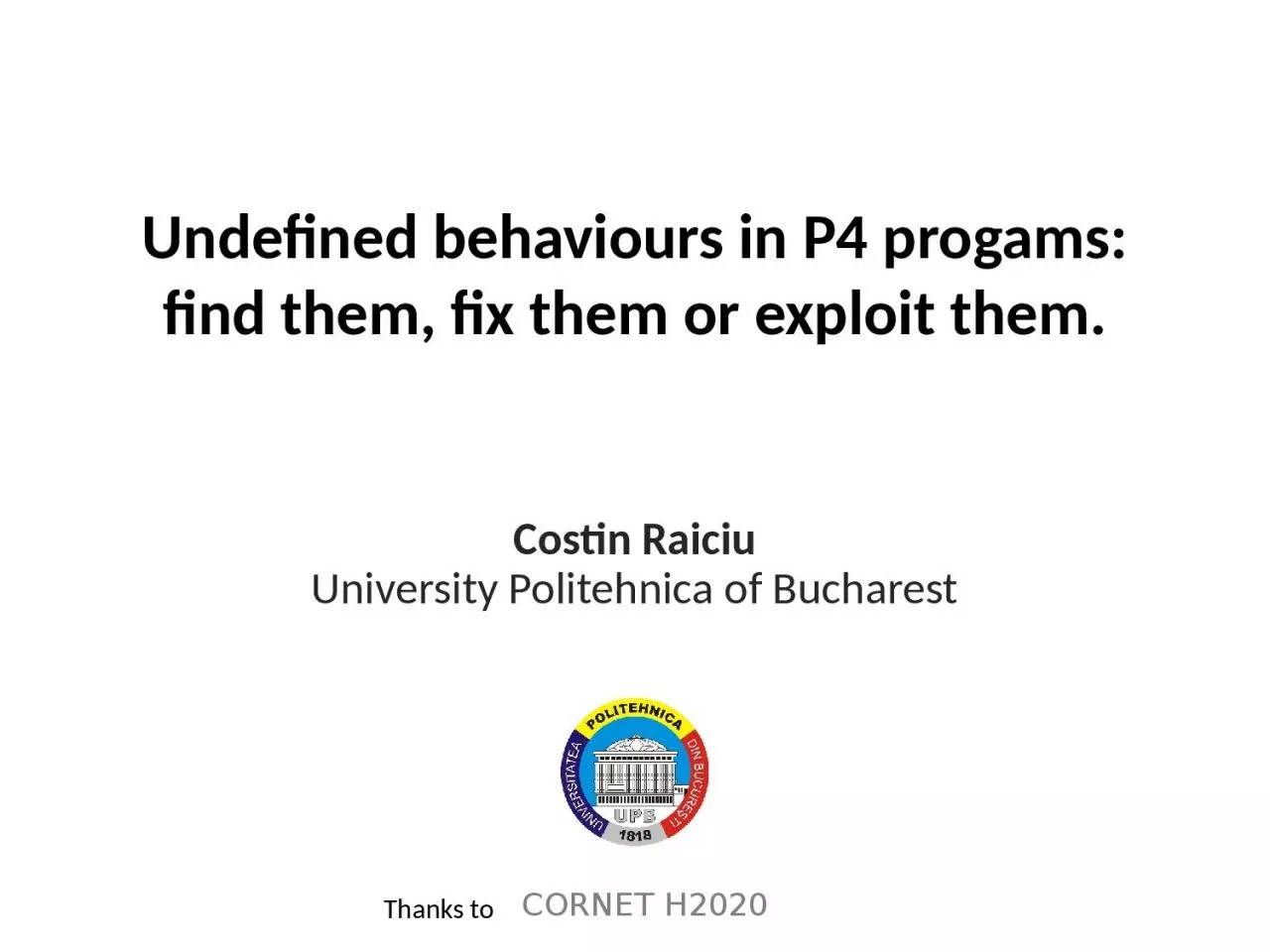PPT-Undefined behaviours in P4
Author : jaena | Published Date : 2024-02-09
progams find them fix them or exploit them Costin Raiciu Thanks to CORNET H2020 University Politehnica of Bucharest P4 by example route and encapsulate What packets
Presentation Embed Code
Download Presentation
Download Presentation The PPT/PDF document "Undefined behaviours in P4" is the property of its rightful owner. Permission is granted to download and print the materials on this website for personal, non-commercial use only, and to display it on your personal computer provided you do not modify the materials and that you retain all copyright notices contained in the materials. By downloading content from our website, you accept the terms of this agreement.
Undefined behaviours in P4: Transcript
progams find them fix them or exploit them Costin Raiciu Thanks to CORNET H2020 University Politehnica of Bucharest P4 by example route and encapsulate What packets the switch accepts and outputs. Target behaviours rank in priority 5742257455573905737657393 b Known warning signs of impending behaviour 57422574555739057393 5742257455573905737657394 5742257455573905737657394 5742257455573905737657395 5742257455573905737657395 574225745557390573 Dr Guy Bohane. University of Roehampton Business School, London. 1. st. Welsh National Conference on – . Excessive Gambling Wales 15. Pierhead. Building, Cardiff Bay. 24. TH. June 2015 . A losing Bet? Alcohol and gambling: investigating parallels and shared solutions, Alcohol Concern . © . 2006-2012. . Dorothy Dalton. Tuesday 2. nd. October 2012. The Theory. Characteristics of best practice boardroom behaviours . (ICSA). a . clear understanding of the role of the board;. the appropriate deployment of knowledge, skills, experience, and judgment;. by adolescents . in . Hong Kong . Consumption . Behaviours. Liberal Studies. Personal Development & . Interpersonal Relationships. Learning Targets. What are the factors . and impacts of teenage . (Enhydra Lutris Nereis). By: Lyndsey Burk, Michael Kuykendall, and Sara Downing. In 1938 scientists first noticed a decline in the southern sea otter population.. When only 38 were still alive, they were placed on endangered species list.. Agenda. Expected Behaviours of Board Members: First and Sixth Principles. Discussion Groups. Plenary reflections to move . forward Governance . &. . Leadership . within Sport in . Wales……. My . Agenda. Expected Behaviours of Board Members: First and Sixth Principles. Discussion Groups. Plenary reflections to move . forward Governance . &. . Leadership . within Sport in . Wales……. My . Behaviours and leadership traits. Commissioning for culture and sport. 5. th. December 2014. Facilitator: Linden Rowley. The workshop outline. A commissioning environment . Behaviours . Leadership traits. Imagine that . the Board . of . Trustees . at school . are discussing . whether Cambridge High should continue to offer outdoor activities, as they are concerned about student’s physical and mental safety. . A resource for school leaders . to use with school staff as part of the . 7 Values in 7 months initiative. Purpose of 7 Values in 7 Months initiative in . schools (7 in 7). What . are DET’s Values? . cannot be defined by using other figures. The undefined terms . point. , . line. , and . plane. are the building blocks of geometry.. Undefined terms. Point: An undefined term in geometry, it names a location and has no size.. BEHAVIOURS OBSERVED CHECKLIST Completed by First and last name and titleDate Completed Worksite Department location room Date of Incident Relationship to Workplace Staff Occasional Staff Lesson 1: Health Behaviour . Making Every Contact Count. Play your part . in changing lifestyle behaviours. and help prevent chronic disease. RECAP UNIT 1. T. he concept/definition of health. & personal wellness. PRACTICAL . APPLICATION . OF . FORMAL METHODS . . TO. . SUPPORT. . ISO . 26262. . /. . ISO. . 21434. . COMPLIANCE. Fabrice DEREPAS, . TrustInSoft. CEO. Improve Software Quality . Contain cost and time to market delays .
Download Rules Of Document
"Undefined behaviours in P4"The content belongs to its owner. You may download and print it for personal use, without modification, and keep all copyright notices. By downloading, you agree to these terms.
Related Documents














